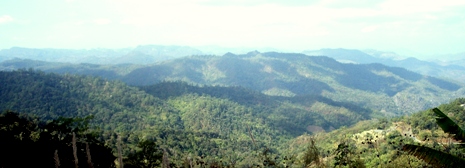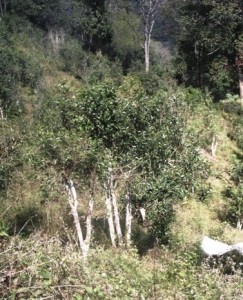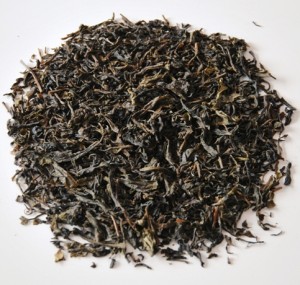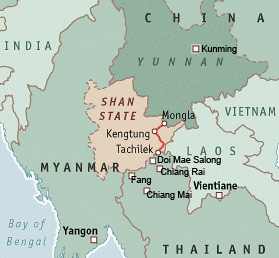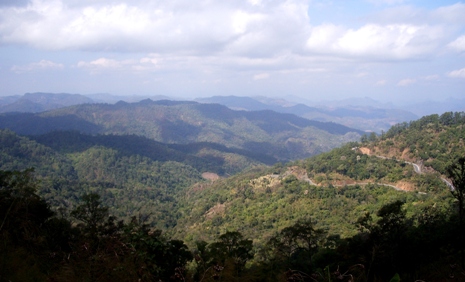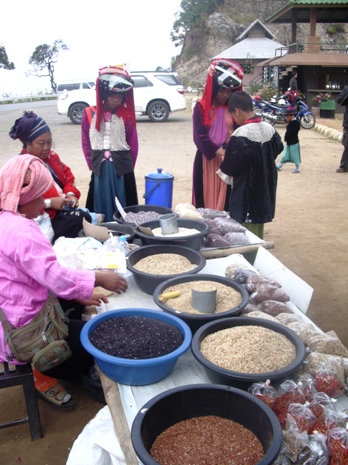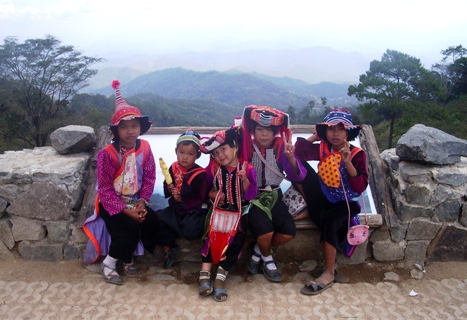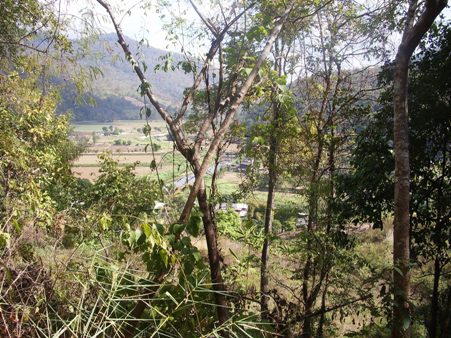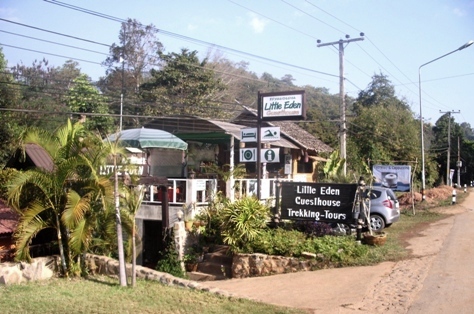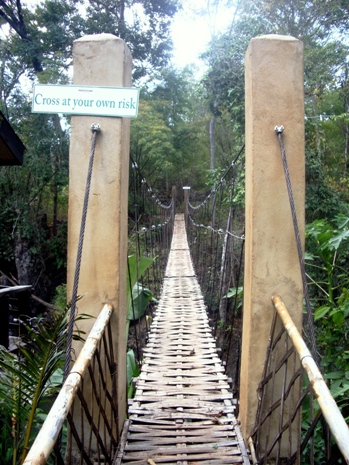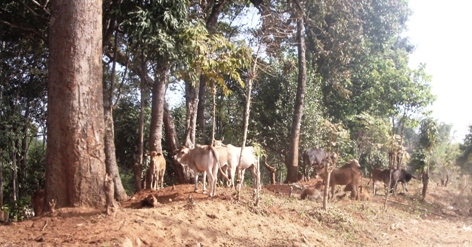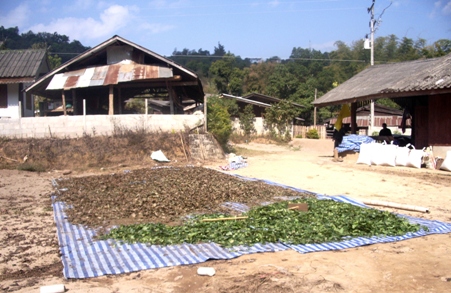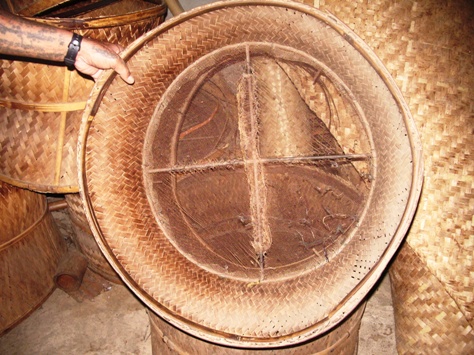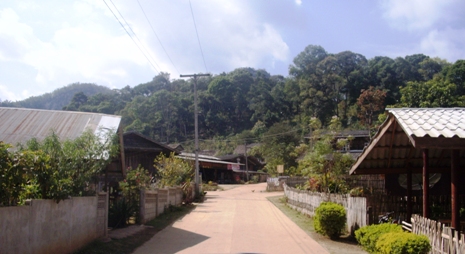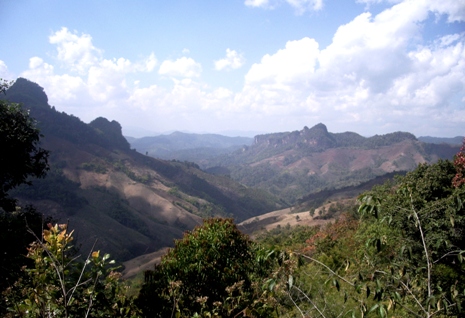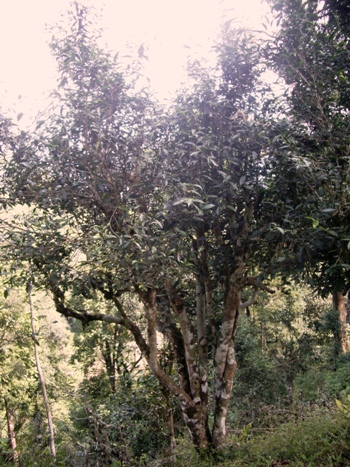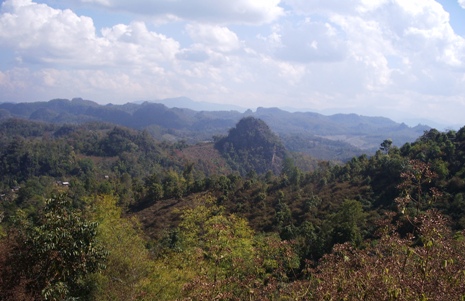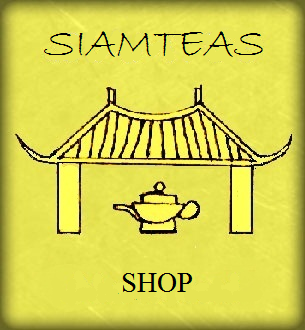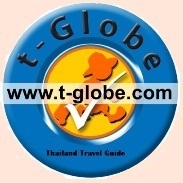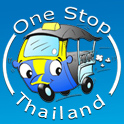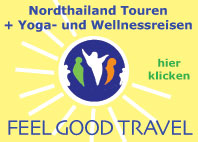Our trip to Pang Kham, Northern Thailand, near the Burmese border, is closely connected to our
where we buy greater amounts of a fine, traditional Pu Errh style tea, as it has been grown for hundreds of years by Northern Thai and Shan people from small farmers along the border, providing them with a sales market and a livelyhood. of the op. ping them llTeapAfter sampling an excellent dark Oolong tea from the highland area close to the the border of Thailand and Burma, we were really curious about the exact location, and methods of the tea cultivation native to the area. After some research we found that the tea was produced in Pang Kham, a village located in the Northern Thai province of Mae Hong Son. Pang Kham is quite remote, only two miles from the Burmese border. The village’s inhabitants are ethnic Shan. They have been populating the area on both sides of the border for hundreds of years. They grow a tea species that is local to the area, and produce a dark, delicious Pu Errh style tea.
With the help of the German help organization Help without Frontiers that has specialized in relief projects for Shan refugees from Burma, and the Shan Health Committee, we have planned to visit Pang Kham and see the tea production for ourselves. Both organizations were essentially involved in a tea growing initiative to improve the livelihoods of Shan refugees seeking shelter from the cruel ethnic policies of the Burmese Military.
Starting from Thailand’s second largest city Chiang Mai, the road to Pang Kahma first leads north, three hours through the mountains via Pai, then another hour and a half to Pangmapha, the last stronghold of civilization on our trip to the border. On the following map think of a point a little west of Doi Mae Salong.
On the way, we stop at a viewpoint not too far from Pangmapha, where we plan to spend the night.
we met some residents of the surrounding Lisor (a local hill tribe) village that sell their homegrown mountain rice along with their traditional handicrafts to passing tourist.
The younger ones earn some pocket money posing fort he tourists in their traditional outfits in front of the spectacular background.
Just the youngest one doesn’t really know yet, what it’s all about …

At Pangmapha, a tiny village, where we hardly expected more than the one or two simple Guest Houses, but there have obviously changes taken place during the past decade and Phangmapha has meanwhile gained a reputation as an excellent base for hiking trips and treks to the surrounding villages. Also there are several large and unique limestone caves located nearby.
As a result, besides the old-established backpacker guest houses, a handful of higher standard (and higher price!) resorts have meanwhile taken up operations. We decide on the very reasonable, German-run, Little Eden Guest House, which combines a friendly atmosphere, individual style, and excellent accommodations.
The main attraction of Little Eden, are not the great food, or the resort‘s individually styled bungalows and little family houses, but a swing bridge only seen in Hollywood movies. The bridge leads across a river to a hiking path that winds through a dense and otherwise virgin jungle.
Early the next morning, we meet with our escort, a leading member of the Shan Health Comittee, who had insisted on accompanying and introducing us. We later realized, without the authority and popularity of our guide, we would have been stopped and sent back at one of the first of several military checkpoints on the dirt road leading to the border.
We travel on the bed of a pickup truck, enjoying the overwhelming panoramic views and sceneries passing us by. Only taking photographs turns out to be rather difficult under these circumstances, constantly clinging to the truck with one hand and holding the camera in the other, while our truck proceeds steeply up the mountain on a dirt road that basically consists of one big pothole. We hardly see any people, just the cattle of the mountain tribes, whose little villages hide in the sourrounding forests, shows that there are people living here at all.
The highland panorama surrounding us more than compensates us for every arguable discomfort. Besides us, the truck carries loads of used clothes and blankets, supplies for the refugees stuck without any means on the other side of the border. Your might think of Thailand as a country that’s always nicely warm, but this doesn’t apply to this area of an altitude of up to 2000 m, where in November to March the temperatures might drop to little more than 0°C at night.

We pass an amazing number of military checkpoints, where we are only allowed to pass due to out escort’s grade of popularity and an official paper he is carrying, which seems to magically open doors and gates for us. After a good one hour bumper ride, the road is suddenly paved again and our destination appears in front of our eyes, Pang Kham, the tea village in no-man‘s-land.

During our ride, we had vainly watched out for tea plantations, the way we are used to them from Doi Mae Salong or other Northern Thai tea cultivation areas. Since we didn’t spot any, in fact not the slightest sign of a tee plant, our expectations concerning tea gardens have dropped to are fairly moderate level.
After entering the 500 souls village in the middle of nowhere, connected to electric power supply for not even 2 years, we drive up in front of the home of our host, the Shan farmer we got the first load of ShanTea from through the intermediation of the Shan Health Committee. Amazingly, the first thing we see is a pile of tea leaves spread in the yard for sundrying. What we see here is an essential processing characteristic of the Pu Erhh tea method, the sun drying: after bringing the natural oxidation/fermentation process in the tea leaves to a halt, the tea is, other than with green tea, completely dried in the sun. The picture shows fresh, still green tea leaves next to a load of already widely dry tea.
Our host offers us a warm welcome and a cup of tea that we can hardly say no to. The tea offered is, of course, the local “home brand, a Pu Errh style processed, lightly charcoal fire-roasted tea harvested from tea trees growing wild here in the mountains. The infusion is drunk after only a few seconds, the leaves then left in the pot. The tea tastes pleasantly grassy, quite like some of the Yunnanese Pu Errh teas I know, but still somhow very particular. After 2 – 3 minutes, however, the tea becomes too intensive for us, due to the tea leaves left in the pot. An option now would be filling up the pot with hot water again, though I personally prefer pouring the tea into a second tea pot after achieving the desired strength.
After some friendly small talk, where our escort takes the role of a translator, since the Shan framer obviously doesn’t speak much Thai, we are invited to visit his tea „factory“, which is accommodated in a medium-sized hall beside his house (see picture above).
We are informed that the now near-empty hall during harvest times (3 times a year) is widely filled with tea, transported here by means of the baskets of which we see a bunch stapled in the back of the hall (see picture below). The baskets, as we learn later, as also used for the roasting process of the tea.
In Shan language (again with our escort, who speaks an excellent English, translating), the tea farmer explains his processing method to us. The machines and facilities are principally typical and similar to those whe have seen in Doi Mae Salong, only that the equipments here appear clearly more old-fashioned and work without electricity. Just like in Doi Mae Salong, there’s a (here: fire-) heated drum, in which the tea is rotated for 10 minutes to stop the natural oxidation/fermentation process of the tea leaves.
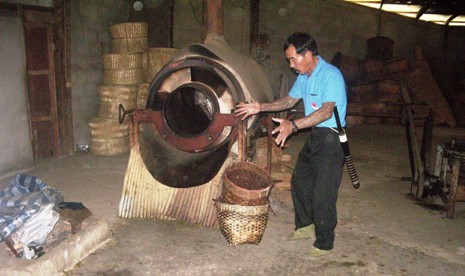
After about 10 minutes, once this process is completed, the tea leaves are removed from the drum and put on a special churning machine, where the are rotated for another 10 minutes to bring them into the curled form they will later have ready for sale in their packages. This cycle of processing the tea leaves first in the heater drum and then on the churning machine takes place only once.
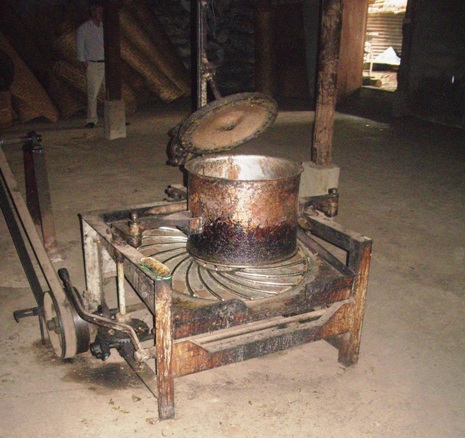
I’m curious and ask if he can produce gunpowder, tool, and I learn that he would need another machine for that (we’ve seen that one in Doi Mae Salong), but is mastering the technique nevertheless. Apart from this, he’s supposedly able to produce a variety of scented teas like rice tea and celery tea (and more) as well. I find that idea pretty appealing and post an inner note for future referral.
Now follows the above mentioned and illustrated process of completely drying the tea leaves in the sun, as it is characteristic for the processing of Pu Errh tea.
For the production of the “home brand”, the tea then undergoes a third process: the roasting on a charcoal fire. For this, the tea is first transferred into one of the aforementioned baskets, woven from bamboo strips.
This basket is then put on the dedicated device, where a charcoal fire is already glowing. The baskets thereby not only amaze with their aesthetic properties and multi-functionality, but also with their obvious heat resistance capacity.
After the factory visit, the farmer and his family invite us to join their traditional Shan lunch, specially served for us in a moderately spicy fashion. Though we don’t know in detail, what exactly we are eating, everything that come on the table tastes so delicious that our hosts, at the sight of our obvious appetite, are already getting afraid not to have cooked enough.
After lunch, we talk about Pang Kham. The village was estabished in the 1940s by Shan migrants from Shan State. To the present day, there are new inhabitants arriving from there, now, since the seizing of power by the Military regime in Burma, they are mainly rather refugees than just immigrants. Apart from the young people born in Pang Kham, hardly any of the residents carries a Thai ID card.
On my request, our Shan tea farmer generously offers himself to show us his tea plantations. Again, we use the pickup truck, with us back on the load bed. At this occasion, we get to see the rest of Pang Kham. The village center appears nicely clean and orderly, not at all as we would have imagined a village located far out of civilization in the middle of no-man’s-land.
At the edge of the village are the shelters of the less established or just recently arrived residents.
Then follows a breakneck bumper ride on roads that don’t really deserve that term, not even according to Thai standards. Once again breathtaking panoramic sceneries open up for us, offering a view reaching far into the mountainous landscape of this part of Burma.
Finally, our truck stops dead in the middle of the road and our hosts asks us to dismount. Only on second sight I realize that we are actually right in the middle of a tea plantation. All around us, there are tea trees seemingly randomly scattered, with coffee plants and other trees dispersed between them in irregular patterns (or no patterns at all, for that matter).
We learn that there already a few hundred years ago, there was a Shan village located a couple of kilometers north of Pang Kahm, whose inhabitants had cultivated these tea plants. Jowever, when the first residents of Pang Kham settled there, that village was already found abandoned and the tea trees left as an inheritage. Our host tells us that his father, a tea farmer himself (who supposely lived to become 99 years old), passed the skills of tea cultivation on to him, when he was a kid joining his father growing tea in Shan State. So, when he arrived here just 5 years agon, he couldn’t help seeing the available abundance of tea trees at Pang Kahm (over 10000 trees) as a generous gift of god.
What impresses me most is that the tea is grown here without any addition of fertilizers, herbicides or pesticides whatsoever, meaning this tea really is 100% organically grown, something often certified nowadays, but rarely true. The tea trees, which are partially up to 2 m high, with trunks up to 15 cm thick, are regularly cut back to keep their leaves accessible for harvest and promote the formation of new tea leave sprouts.
After our return to Pang Kahm, it’s time to say goodbye to our sympathetic escort, guide and translator. He will continue “traveling” across the green border from here to fulfill his duties in the political representation of the Shan people and to bring aid goods to the refugees hiding from the Burmese army in the forests on the other side. Since there are no roads there, he won’t need the pickup truck, while we are once again the lucky Westerners gifted by birth, who are presented with a car including a local driver to be able to return to their fancy resort.
Our driver readily stops a few times on the way, so I can at least document some of the scenic views continuously passing by to our left and right.
My trip to Pang Kham once again led me to encounter new places and new people in the pursue of tea and the places it is made, a thought that I can’t help myself pondering for quite a while that night before falling asleep.

